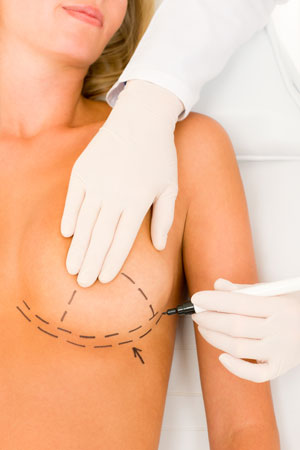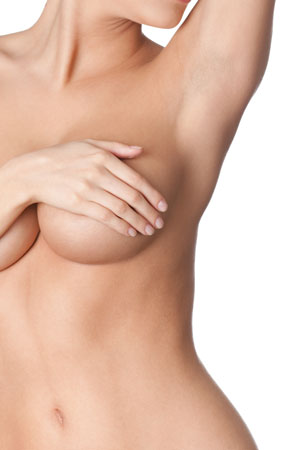
The vast expansion in the range of breast implant designs available has brought a degree of precision to the operation of breast augmentation that did not previously exist. It has however also engendered a degree of confusion in those considering undergoing this operation. The following is not meant to replace proper consultation with your plastic surgeon. It can however be considered a thumbnail guide to what’s available in breast implants.
Saline versus Silicone
The status here can best be summed up by the fact that in no market where both implants are widely available does the saline-filled implant exceed the silicone gel implant in popularity. The gel-filled implant is superior in a more lifelike feel, a reduced incidence of problems such as rippling and ridging, increased reliability and reduced leakage rate. It’s only in parts of the world where silicone gel filled implants are not widely available that the saline-filled implant outnumbers it in usage.
Textured versus Smooth-Walled
These two implant shell designs attempt to achieve the same result (i.e. a soft natural result) by different methodologies. The saline-filled implant is generally placed in a large pocket and massage is encouraged to maintain this space. The principal is that smooth implant will slide around within the larger space, move on touching and feel soft.
Conversely the textured implant is generally placed in a more snug space. Massage is not overly encouraged by most plastic surgeons as the implant design is such that close contact with the developing scar capsule is encouraged in the belief that the textured wall predisposes the scar capsule to form in such a way as to evolve into a softer result.
Both can achieve good natural results although some plastic surgeons prefer the textured device due to the more predictable nature of the defined extent of the scar capsule. There is data to suggest that the textured device also reduces the risk of capsular contracture at least when the implants are placed in front of the muscle and behind the breast glands. It seems that when implants are behind the pectoralis muscle the difference in the two devices is not statistically significant.
Round versus Anatomical
Once a base diameter is decided upon and these days this is usually based around measurement of the individual’s breast, then round implants can only vary in their degree of projection.
With anatomical implants however variation can be gained not only in the degree of projection but also in the vertical height of the implant i.e. how far it extends up the chest wall.
This wider range of devices in the anatomical implant means that degrees of breast asymmetry which are extremely common can now be adjusted for, with variation in implant shape to reduce overall asymmetry and obtain more evenly matching breasts. Anatomical implants may also be more useful for masking breast ptosis (sag) and with their textured walls placed in a snug surrounding scar capsule provide more predictable and enduring long-term results.
Gel Density
The available data suggests that those implants made of denser gel designs have greater longevity and are less prone to rupture for any given time duration. Naturally enough therefore many surgeons have gravitated towards these denser implant designs. Whilst no implant can be thought of as a permanent device it can generally be expected that denser implant gel designs will last longer. These gel designs are generally found in the anatomically-shaped devices although round implants also come in at least two different types of gel density.
 Polyurethane Coating
Polyurethane Coating
The polyurethane coated implant has achieved the name “furry Brazilian” as up until few years ago these devices were only used in South America. They are not however new devices and date to the seventies where they originally used in the USA and Europe. They were withdrawn from the American market in 1991 due to concerns that the breakdown product of the polyurethane was carcinogenic, as it has been shown to be so in animals. The available data from South American studies would suggest that this is not however the case in human beings and these implants have therefore been allowed back into many of the world markets in the last five years. The data available would suggest that they offer an advantage in the patient who has had a number of surgeries in the past with other implants complicated by significant capsular contracture (hardening). However as modern techniques have vastly reduced this complication in incidence the number of patients who are likely to benefit from this device used as a routine is relatively small. Some plastic surgeons having seen the debacle of the PIP implant saga are awaiting more data to accumulate multiple world centres on the polyurethane coated device before advocating there routine usage in breast augmentation, reserving them instead for the few patients with recurrent hardening where they have been shown to be of benefit.
Implant Pocket
Along with any discussion of implant designs one must also include a discussion of the advantages of sub-glandular verses sub-pectoral implant placement.
Where soft tissue coverage is good and there is adequate breast and subcutaneous fat lifelike results may be obtained with both implant placements. Where the subject is particularly thin (or perhaps even in the more adequately covered patient in the long term) the implant may be more likely to become exposed and easy to feel or see. This often manifests itself as visible folds or ripples.
Placement behind the muscle in particular tends to cover the upper pole of the breast and this is the area most visible in common types of clothing.
A second advantage of placement behind the muscle is the reduced risk of capsular contracture (hardening) seen with breast prosthesis in this space.
As you will gather from the above discussion there are shades of grey in all the topics mentioned. The consultation for breast augmentation is particularly important as it allows the plastic surgeon and their patient to select an implant not only of an appropriate size but also of appropriate design to match their breast shape and size and their desired result. Good communication with an experienced plastic surgeon adapted using the variable types of implant is your best option for arriving at the result closest to your desires. Sizer kits and 3D imaging systems are further auxiliary devices to help you arrive at the right result.
One further disadvantage of the medical tourism option is that apart from the appalling lack of long term follow up of patients, many of the modern implant designs are not yet available in the third world or their costs are too prohibitive to permit use there.
All these factors need to be carefully considered before making an informed decision about an important aspect of your ongoing health care.


